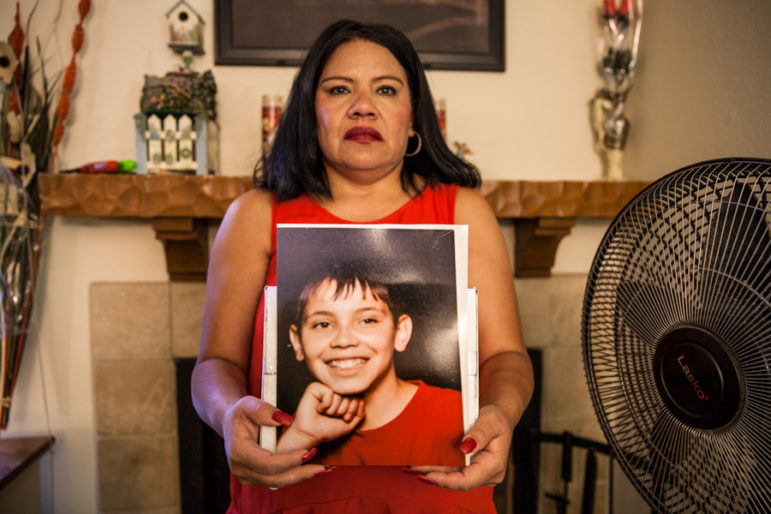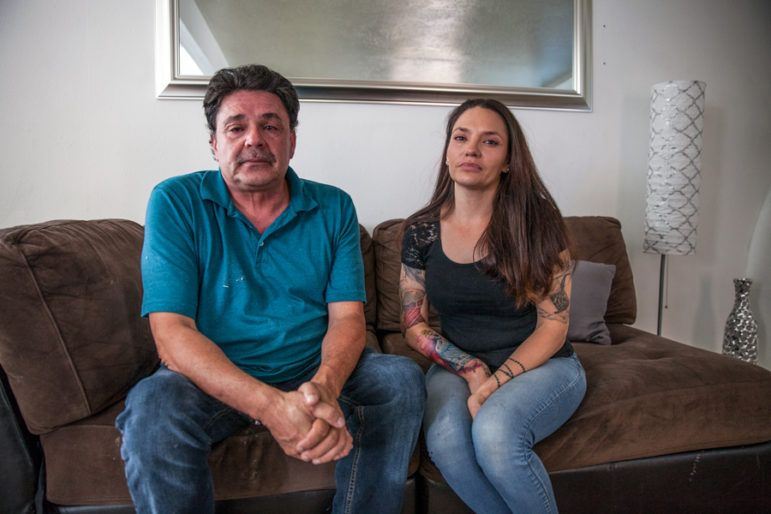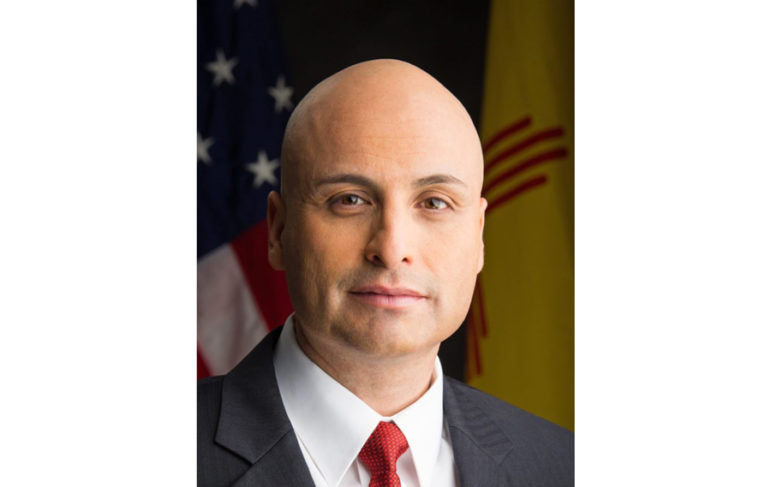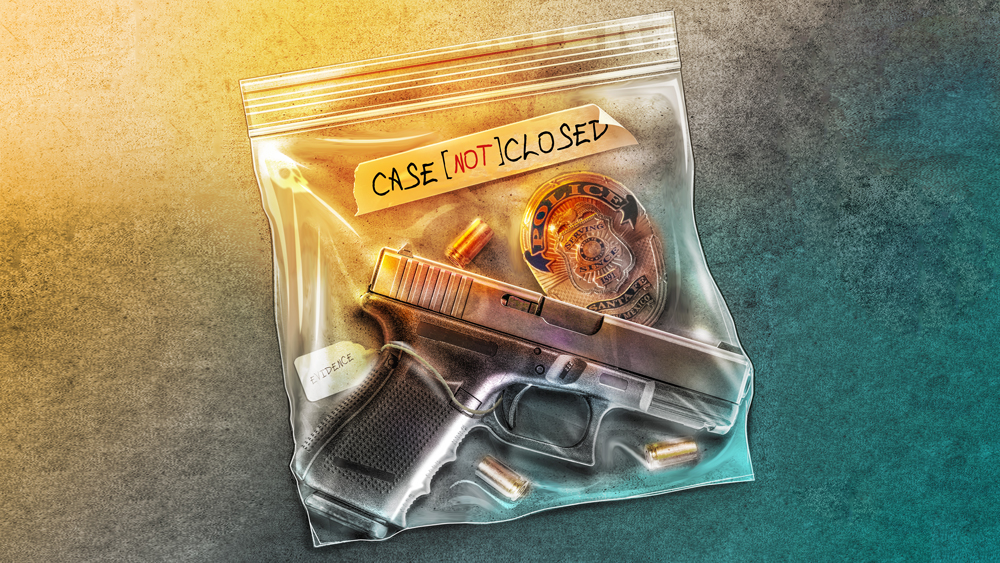Elizabeth Palma and her son, Anthony Benavidez, loved trips to the cinema. In early 2017 they enjoyed Disney’s live-action remake of “Cinderella” together.
It would be their last movie.
Months later, Benavidez, 24, lay fatally wounded by police in a Santa Fe apartment that bore the marks of his isolating schizophrenia: walls painted black, aluminum foil covering a bedroom window, heavy blinds draped over another.
City officials paid his family $400,000 to settle a civil lawsuit after the killing. The two shooting officers have admitted to serious missteps, but whether they broke the law when they shot him during a SWAT standoff has never been fully determined. More than two years later, Palma, Anthony’s half-sister, Roseanne Lopez and his father, Phil Benavidez, are still waiting.
A decision on the question came first in the spring, after First Judicial District Attorney Marco Serna had referred the case to a panel of three outside prosecutors. They determined the officers hadn’t committed a crime, and Serna said he wouldn’t charge the officers.
In response to inquiries for this story from Santa Fe Reporter and New Mexico In Depth and months after he made the same pledge to the family, Serna offered a tepid promise: The first-term Democratic DA running for Congress said he would appoint a special prosecutor to take a second look, but only if the family’s lawyers provided “additional information.” They contend they have done that; he disagrees.
The case isn’t closed, but it’s not much open, either.
The morass spotlights a longstanding problem with how police shootings are handled in New Mexico, where officers have killed more people by population than in any other state three of the past four years, according to data collected by the Washington Post and analyzed by SFR and NMID.

How district attorneys decide whether an officer’s action crosses over into criminal conduct in a shooting differs from one district to the next, and the processes are secretive. That sows distrust, especially in non-white communities, where the effects of over-policing nearly always hit hardest.
Shooting reviews also can drag on, sometimes for years, leaving victims’ families and officers alike on tenterhooks. After they’re completed, those making recommendations to a DA aren’t required to describe how they reached their decisions.
The current system represents an evolution from an earlier process that came after an SFR and NMID investigation in 2016. But the state hasn’t settled on a consistent way to handle police shooting reviews quickly and in a way people understand. Fourteen DAs practice in New Mexico; they’re all free to handle the reviews whatever way they like.
It appears, however, that state lawmakers, civil rights advocates and even prosecutors are prepared to make a change. A centralized system, housed in the state Attorney General’s Office, somewhere else in state government, or in a whole new division, feels closer than ever.
Rep. Patricia Roybal Caballero, D-Albuquerque, sponsored a bill in 2017 to place all reviews in the state Attorney General’s Office—a proposal that died in committee. She says it’s time to standardize how police shootings are reviewed across the state and she’s prepared to sponsor legislation again to do it.
“That after all these years we still don’t have a uniform system absolutely demands a legislative solution,” Roybal Caballero, who is Hispanic and a member of the Piro Manso Tiwa Pueblo, tells NMID and SFR. “The killing needs to stop and our communities need to be safe places. My sons are targets right now because of the color of their skin. I fear every single time my son is out and about in Albuquerque.”
Phil Benavidez believes his son’s shooting would have been reviewed differently had Anthony been white with a “different last name.”
“Santa Fe’s known as the City Different,” he says in a tearful interview in his daughter’s kitchen, “it shouldn’t be the city indifferent.”
Serna says he understands the family’s concerns—especially the two-plus years the case has gone unresolved.
“But I respectfully disagree that race had anything to do with how this has been handled,” he says.
Still, Serna says he’s open to change. He supports the idea from Roybal Caballero’s long-dead bill: create a unit in the AG’s Office to handle all police shooting reviews, remove ambiguity from the process and speed it up.
AG Hector Balderas also favors a single process for the state.
He would be happy to bring a specialized police-shooting division into his office, he says, but only if the Legislature invests enough for him to do it right.
“We are a Top-10 state in an area like loss of life in officer-involved shootings—there needs to be that type of funding commitment,” Balderas says.
An independent agency, wherever it’s housed, would cost significantly more than the $1.5 million Roybal Caballero proposed to set it up in 2017, he notes, though he did not suggest a figure.
No one interviewed for this story suggested designing a system that results in more police prosecutions; rather, they all want something that moves faster, is out in the open and engenders more trust.
The question is, what should replace New Mexico’s current patchwork system for reviewing police shootings? The AG’s Office is one option, but there are others, including a brand new division within state government, or handing the whole process over to public defenders.
Different but not Better
More than three years ago, NMID and SFR examined this issue in detail and found many of the same problems—an unreliable, inconsistent batch of systems few people trusted.
Most prosecutors reviewed police shootings for criminal conduct in-house; one automatically appointed a special prosecutor; and two, in Alamogordo and Santa Fe, used “investigative grand juries.”
By then, Albuquerque judges had banned the investigative grand juries because of a pro-police bias and legally fragile underpinnings. Prosecutors had complete control, and the grand juries couldn’t indict officers even if they believed a crime occurred.
Serna, like those he was running against in the Santa Fe DA’s race in 2016, vowed to abandon the grand juries and after he was elected chose the relatively new “DA panel” process.

New Mexico DAs can ask the state District Attorneys Association to appoint a three-prosecutor panel to review a shooting. The aim is to avoid the perception that a local DA might go easy on police officers who help make their cases each day.
Three other DAs use the same system as Serna, says Rick Tedrow, the 11th Judicial District Attorney who runs the panels for the association. Over the last three years, the panels have reviewed six cases in four districts, he says, recommending in each that the shooting officers be cleared.
“I have mixed feelings about how it’s gone so far,” Tedrow says. “It’s unfunded, so it always comes down to finding time to get it done. It can be time consuming, and there’s been plenty of criticism of that. It could run smoother, but that would take money, and it doesn’t seem like there’s any of that coming.”
Another thorny issue: The panels aren’t governed by state law, and DAs aren’t bound by their recommendations.
“Like any new process, nothing’s perfect,” Serna tells NMID and SFR. “But I do think it’s the best system we’ve had. Unfortunately, they do take a while, but the DAs have extremely busy schedules, and they aren’t paid for this work.”
Shannon Kennedy, an Albuquerque-based civil rights lawyer who represents Benavidez’ half-sister and father, says the panels present a deeper set of problems than the grand juries.
“With the grand juries, once we got to see how they worked, we could see the biases, and we had a way to challenge the murky way in which they operated,” Kennedy says. “With the panels, we now face infinite delays, no transparency in terms of how they reach their decisions and, in some cases, we’ve had to sign confidentiality agreements in order to get documents and other records while the panels did their work.”
That amounts to a “gag order,” she says, adding that she believes prosecutors are intentionally delaying the reviews “until the information becomes stale and they can ride out another news cycle.”

Serna says he can’t comment on transparency concerns about the panels because no one has raised the issue with him.
Most prosecutors around the state still choose to review police shootings in their districts themselves; two are now automatically appointing special prosecutors.
Regardless of the mechanism, police prosecutions are rare in New Mexico, as they are nationally. Two officers were tried in 2016 for murder in the killing of an Albuquerque homeless man—the first such prosecution in state memory. It ended in a hung jury.
But a trial is exactly what Palma, Benavidez’ mother, wants.
“For me, justice would be for those cops to get prosecuted and for the whole of Santa Fe to be more aware of mental illness before it gets to this point,” she says through tears. “I miss him, and I wish he was here today.”
The Benavidez shooting—and its mirror
Benavidez’ father, Phil, says his son’s IQ was once measured at 155. He plowed through the first Harry Potter book at age 5. He scored well above his peers on diagnostic math tests.
His sister, Roseanne Lopez, says her brother loved Eminem and spent many holidays at her Albuquerque home.
“He was always around here,” she says, then stops, pauses, and adds that the pain of losing him hasn’t lessened in the two years since he was killed.

In the months before his shooting his illness had worsened, his family says, and he wasn’t good at taking his medication—even when they could afford the $500-apiece prescriptions.
In July 2017, he was evicted from his apartment for not paying rent. Deputies took him to Christus St. Vincent Regional Medical Center for a psychiatric evaluation. Benavidez left the hospital with a social worker he knew, then disappeared. The social worker visited the apartment a few days later. Benavidez came out and stabbed the man.
The SFPD SWAT team showed up, escalating the situation, and Benavidez tossed a propane tank tied to fireworks and a tube filled with a bleach-like substance out of the apartment at officers.
After a lengthy standoff, officers Jeramie Bisagna, Luke Wakefield and Nick Wood stormed the apartment, using a metal rod to smash a window. Wakefield was wearing sunglasses, which he later admitted to State Police investigators was a “horrible idea,” given the darkness inside the apartment. Bisagna imagined he saw a gun in Benavidez’ hand, though none was found at the scene.
Wakefield screamed at Benavidez to show his hands; Bisagna emptied his magazine into the apartment—16 shots—and Wakefield fired once with his rifle. Benavidez was struck four times and died soon thereafter.
It’s impossible to see whether Benavidez posed a threat to the officers as they opened fire through the window from their positions outside the building. That’s because Bisagna’s camera might have been the only one pointed in Benavidez’ direction, but he inexplicably turned it off seconds before approaching the apartment—apparently in violation of SFPD policy.
Both officers remain on the force and each has been promoted since the shooting, Bisagna to sergeant and Wakefield to detective. A department spokesman says an internal affairs investigation into whether they violated policies the day of the shooting is “still active.”
That’s left the officers in limbo, wondering about their jobs and whether they’ll be prosecuted, says Thomas Grover, Bisagna’s attorney and a former officer himself.
And that’s one of the problems with the DA reviews taking longer and longer, Grover says.
“Absolutely, we need a system that’s the same around the state,” he says. “This buffet-style review system we have now is not working for officers, either. … It’s like waiting for a diagnosis from the doctor over a significant concern you have, that never seems to come.”
State Police investigated the Benavidez shooting for 10 months before handing the case off to the DA panel, which took nearly a year to arrive at its conclusion that the officers shouldn’t be prosecuted.
The panel worked in secret, and none of the three DAs will comment publicly about how they reached their conclusion. A single paragraph in the panel’s seven-page findings letter is the public’s only glimpse.
Serna won’t discuss it either, saying he needs to keep the review at arm’s length to avoid any conflicts.
He is open to appointing a special prosecutor for a second look, he says, and has not ordered the case closed. That means the case is now 26 months old, and there’s no end in sight.
A five-year-old Albuquerque case makes that space of time seem short.
APD officer Jeremy Dear shot Mary Hawkes to death April 14, 2014.
Her family, also represented by Kennedy, is waiting, too.
Bernalillo County DA Raul Torrez assigned the case to a special prosecutor in 2017, the stated preference on his official website. (Torrez, who was also one of the prosecutors on the panel that reviewed the Benavidez shooting, did not respond to multiple requests for an interview for this story.) Two and a half years later, the special prosecutor recommended no charges.
Six months after that, last October, Torrez sent the case to a DA panel for a second look. The panel has not reached a conclusion.
“It’s an open wound for that family, and they relive it again every April 14,” Kennedy says. “The truth will always be elusive. But we absolutely need a uniform process, especially with such high rates of police violence around the state. And we need something that the public can trust, at least a little more.”
The AG? The public defenders?
The federal government does not track fatal police shootings. So the Washington Post began doing so in 2015, following heightened national awareness and tensions around police violence after a white officer shot a black man to death in Ferguson, Mo.
NMID and SFR’s analysis of the Post’s data reveals the scope of New Mexico’s problem: In 2015, it ranked second for fatal police shootings per 1 million people. In 2016, 2017 and 2018, New Mexico ranked first. To date this year, New Mexico ranks sixth.
Those numbers have concerned Roybal Caballero, the Albuquerque Democrat, for years. Her 2017 bill, which would have created a statewide unit in the AG’s Office for police shooting reviews, found some support early on during the legislative session that year, but it failed.
“It didn’t end up being about resistance from my colleagues,” Roybal Caballero continues. “It was more that the DAs and the AG were saying: ‘Let us work through this process and find solutions ourselves.’ And of course the bill didn’t go anywhere, and I really don’t know what ever came of the DAs’ efforts. It’s clear now that there’s an imperative for the Legislature to address this.”
It’s not clear whether lawmakers will get that chance. Gov. Michelle Lujan Grisham, a first-term Democrat, controls what legislators will consider for the upcoming 30-day session that starts in January. Her office said she was open to an interview for this story, but did not respond to requests to schedule one.
Balderas says the Legislature should decide how to set up a statewide unit—whether it’s in his office, another area of state government or something brand new.

But he warns that New Mexico’s habit of “funding public safety and criminal justice the way they fund capital outlay,” on an individual, case-by-case basis, won’t work for police shooting reviews.
Funding for his most successful units relies on a mixture of his own budget and individual appropriations, he says. “That’s why I’m cautioning the Legislature: Don’t fund another area of need this way. Let’s modernize sufficient funding so that there’s full coverage among multiple jurisdictions.”
Proper funding and a division to review police shootings would have another benefit, as well, he says.
Creating “a just and robust system that satisfies the crisis need of the community … would also increase officer safety,” Balderas says.
A system led by the AG’s office isn’t the only idea.
In a July 29 op-ed published in the New York Times, Joshua Michtom, an assistant public defender at the Connecticut Office of the Chief Public Defender, argues that perhaps prosecutors, with their inherent coziness with law enforcement, shouldn’t be involved at all.
Micthom points out that non-white communities generally trust the police less.
“If mayors, police chiefs and legislatures are serious about instilling real faith in these communities, they should hand over full control of investigations to the one group of lawyers used to treating the police in an adversarial fashion, all of them experts in police rules and procedures: public defenders,” he writes.
In a telephone interview from Hartford, Michtom tells SFR and NMID he intended the piece as a conversation starter, a way to at least clear a path for removing decisions on police shooting prosecutions from local DAs.
“How often would a system like that lead to convictions? That’s not really the question,” he says. “It’s more important that it appears fair.”
Kennedy, the civil rights lawyer, called the idea “brilliant” and said putting public defenders in charge could also remove the fraught politics DAs encounter in police shooting cases.
Bennett Baur, New Mexico’s chief public defender, says his department is resource-strapped. Baur was held in contempt in Lovington in 2016 after refusing to take on new indigent clients, saying he couldn’t uphold his oath as a lawyer because of a crushing caseload.
Still, Baur, in better budget times these days, says he likes the principle Michtom floated.
“Maybe this is a way to end up with some sort of commission, like the way we choose mediators,” he says. “The PDs and the AG choose people — there are enough lawyers in the state to do this — and it could be made up of different interests and agendas. Either way, and our office maybe could do this if there were funding, I absolutely favor uniformity around the state. It’s ridiculous that it takes a year or longer for these reviews.”
Even Balderas says he’s “not closed to” letting the public defenders take over.
Phil Benavidez and his daughter, Roseanne Lopez, know that even an improved, uniform system for reviewing police shootings won’t bring Anthony back.
“He was a special human being,” Lopez says of her brother. “I just hope this never happens to an innocent person again.”
This story was published in collaboration with the Santa Fe Reporter, an NMID partner.

Missing from proposals is one I consider obvious. These cases should go before a REAL Grand Jury, which is Independent of the DA/AG. We forget that the Grand Jury, as designed, is independent of the DA. This all changed in New Mexico, over time, and the Grand Jury is now CAPTIVE to the DA/AG.
We need to reform the Grand Jury, full stop, returning its independence. If they need counsel, an independent counsel can be provided to them. This is the scheme used on the East Cost, where DAs are excluded from the GJ room.
Today’s confusion is due to DAs, and the AG, being POLITICAL creatures more than law enforcement. Imaging them being non-political and unbiased is dreaming. Try thinking of a non-political Balderas or Serna… can’t do it can you? A Grand Jury, reformed and independent, can investigate and indict police officers, and Legislators, even DAs. A REAL Grand Jury, as designed by the Founding Fathers, part of the Bill of Rights.
The solution is obvious, so obvious that our Legislature has destroyed it, as it was a threat to THEIR corruption.